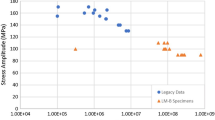Abstract
A study has been made of the mechanics and mechanisms of fatigue crack propagation in a commercial plate of aluminum-lithium alloy 2090-T8E41. In Part II, the crack growth behavior of naturallyoccurring, microstructurally-small (2 to 1000µm) surface cracks is examined as a function of plate orientation, and results compared with those determined in Part I on conventional long (≳5 mm) crack samples. It is found that the near-threshold growth rates of small cracks are between 1 to 3 orders of magnitude faster than those for long cracks, subjected to the same nominal stress intensity ranges (at a load ratio of 0.1). Moreover, the small cracks show no evidence of an intrinsic threshold and propagate at ΔK levels as low as 0.7 MPa{ie563-01}, far below the long crack threshold ΔKTH. Their behavior is also relatively independent of orientation. Such accelerated small crack behavior is attributed primarily to restrictions in the development of crack tip shielding (principally from roughness-induced crack closure) with cracks of limited wake. This notion is supported by the close correspondence of small crack results with long crack growth rates plotted in terms of ΔKeff (i.e., after allowing for closure above the effective long crack threshold). Additional factors, including the different statistical sampling effect of large and small cracks with microstructural features, are briefly discussed.
Similar content being viewed by others
References
Anon: “Airplane Damage Tolerance Requirements”, Military Specification MIL-A-83444, United States Air Force, July 1974.
S. J. Hudak:J. Eng. Math. Tech., Trans. ASME, Series H, 1981, vol. 103, pp. 26–35.
J. Schijve: inFatigue Thresholds, J. Bäcklund, A. F. Blom, and C. J.Beevers, eds., EMAS Ltd., Warley, U.K., 1982, vol. 2, pp. 881–908.
K. J. Miller:Fat. Eng. Mat. Struct., 1982, vol. 5, pp. 223–32.
S. Suresh and R. O. Ritchie:Int. Metals Reviews, 1984, vol. 29, pp. 445–76.
R. P. Gangloff and R. O. Ritchie: inFundamentals of Deformation and Fracture, B. A. Bilby, K. J. Miller, and J. R. Willis, eds., Cambridge University Press, Cambridge, U.K., 1985, pp. 529–58.
J. Lankford:Fat. Fract. Eng. Mat. Struct., 1983, vol. 8, pp. 161–75.
R. O. Ritchie and J. Lankford:Mater. Sci. Eng., 1986, vol. 84, pp. 11–16.
Small Fatigue Cracks, R. O. Ritchie and J. Lankford, eds., TMS- AIME, Warrendale, PA, 1986.
J. F. McCarver and R. O. Ritchie:Mater. Sci. Eng., 1982, vol. 55, pp. 63–67.
K. Tanaka and Y. Nakai:Fat. Eng. Mat: Struct., 1983, vol. 6, pp. 315–27.
J. Lankford and D. L. Davidson: in Ref. 9, pp. 51–71.
L. Wagner, J. K. Gregory, A. Gysler, and G. Lütjering: in Ref. 9, pp. 117–28.
A. Pineau: in Ref. 9, pp. 191–211.
M. R. James and W. L. Morris: in Ref. 9, pp. 145–56.
K. Tanaka: in Ref. 9, pp. 343–61.
W.L. Morris:Metall. Trans. A, 1980, vol. 11A, pp. 1117–23.
R. O. Ritchie and W. Yu: in Ref. 9, pp. 167–89.
F. Heubaum and M. E. Fine:Scripta Metall., 1984, vol. 18, pp. 1235–40.
K. Minakawa, H. Nakamura, and A. J. McEvily:Scripta Metall., 1984, vol. 18, pp. 1371–74.
E. Zaiken and R. O. Ritchie:Metall. Trans. A, 1985, vol. 16A, pp. 1467–77.
K. T. Venkateswara Rao, W. Yu, and R. O. Ritchie:Scripta Metall., 1986, vol. 20, pp. 1459–65.
R. P. Gangloff and R. P. Wei: in Ref. 9, pp. 239–64.
K. T. Venkateswara Rao, W. Yu, and R. O. Ritchie:Metall. Trans. A, 1988, vol. 19A, pp. 549–61.
B. S. Majumdar and S. J. Burns:Acta Metall., 1981, vol. 29, pp. 579–88.
J. Petit, S. Suresh, A. K. Vasudévan, and R. C. Malcolm: inAluminium-Lithium Alloys III, C. Baker, P. J. Gregson, S. J. Harris, and C. J. Peel, eds., Institute of Metals, London, U.K., 1986, pp. 257–62.
K. V. Jata and E. A. Starke: inAluminium-Lithium Alloys III, C. Baker, P. J. Gregson, S. J. Harris, and C. J. Peel, eds., Institute of Metals, London, U.K., 1986, pp. 247–56.
M. Peters, K. Welpmann, W. Zink, and T. H. Sanders: inAluminium- Lithium Alloys III, C. Baker, P.J. Gregson, S.J. Harris, and C.J. Peel, eds., Institute of Metals, London, U.K., 1986, pp. 239–46.
W. Yu and R.O. Ritchie:J. Eng. Math. Tech., Trans. ASME, Series H, 1987, vol. 109, pp. 81–85.
J. C. Nwman, Jr. and I. S. Raju:Eng. Fract. Mech., 1981, vol. 15, pp. 185–92.
M.R. James:Scripta Metall., 1987, vol. 21, pp. 783–88.
S. Suresh and R.O. Ritchie: inFatigue Crack Growth Threshold Concepts, D.L. Davidson and S. Suresh, eds., TMS-AIME, Warrendale, PA, pp. 227–61.
Author information
Authors and Affiliations
Rights and permissions
About this article
Cite this article
Rao, K.T.V., Yu, W. & Ritchie, R.O. Fatigue crack propagation in aluminum-lithium alloy 2090: Part II. small crack behavior. Metall Trans A 19, 563–569 (1988). https://doi.org/10.1007/BF02649270
Received:
Issue Date:
DOI: https://doi.org/10.1007/BF02649270




